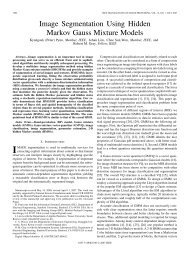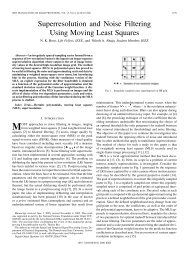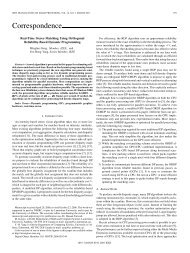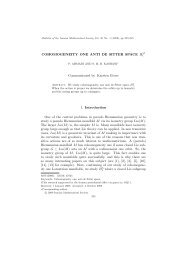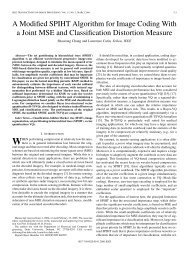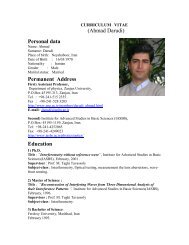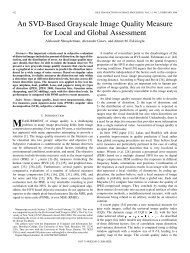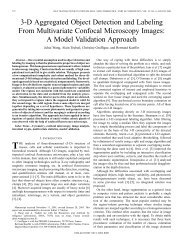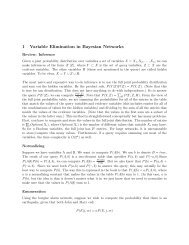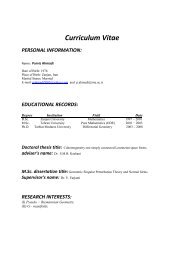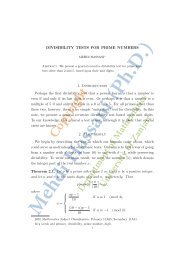Kinetic isotope effects on the (2+2) cycloadditions of diphenylketene ...
Kinetic isotope effects on the (2+2) cycloadditions of diphenylketene ...
Kinetic isotope effects on the (2+2) cycloadditions of diphenylketene ...
Create successful ePaper yourself
Turn your PDF publications into a flip-book with our unique Google optimized e-Paper software.
Downloaded by TARBIAT MODARRES UNIV <strong>on</strong> August 10, 2009<br />
Published <strong>on</strong> May 1, 2002 <strong>on</strong> http://pubs.acs.org | doi: 10.1021/ja01039a059<br />
3106<br />
slow process. Electr<strong>on</strong>ic absorpti<strong>on</strong> spectra <strong>of</strong> aqueous<br />
soluti<strong>on</strong>s <strong>of</strong> <strong>the</strong> two isomers show <strong>on</strong>ly minor changes<br />
over a 24-hr period at 25". It is also interesting that<br />
CO(CN)~~- does not appear to affect significantly <strong>the</strong><br />
isomerizati<strong>on</strong> rates; in an aqueous soluti<strong>on</strong> 0.001 M in<br />
complex and ca. 0.0005 M in CO(CN)~~-, <strong>the</strong> <strong>on</strong>ly<br />
spectral changes noted after 2 hr could be attributed to<br />
<strong>the</strong> expected l2 Co(I1)-catalyzed formati<strong>on</strong> <strong>of</strong> Co-<br />
(CN)B3-. A comparis<strong>on</strong> <strong>of</strong> <strong>the</strong> molar extincti<strong>on</strong><br />
coefficients reported here for <strong>the</strong> electr<strong>on</strong>ic absorpti<strong>on</strong><br />
spectrum <strong>of</strong> K3[Co(CN)bNCS] with those reported by<br />
Stotz, Wilmarth, and Haimlo indicates that <strong>the</strong>ir compound,<br />
formed by <strong>the</strong> direct substituti<strong>on</strong> <strong>of</strong> NCS- into<br />
CO(CN)~H~O~-, is a mixture <strong>of</strong> about 70% Co(CN);-<br />
SCN3- and about 30P;: Co(CN),NCS3-. This c<strong>on</strong>clusi<strong>on</strong><br />
is supported by cyclic voltammetric studies<br />
which show distinctly different electrochemical behavior<br />
for CO(CN)~SCN~- and Co(CN),NCS3-, whereas <strong>the</strong><br />
product prepared by <strong>the</strong> substituti<strong>on</strong> procedure 10 gives<br />
overlapping waves which indicate that both isomers are<br />
present. 13,14<br />
It has been reported that K3[Co(CN)jNCS] isomerizes<br />
to K,[Co(CN),SCN] <strong>on</strong> heating. lo The <strong>the</strong>rmogram<br />
<strong>of</strong> a sample <strong>of</strong> K3[Co(CN)sNCS] prepared by our<br />
procedure shows two irreversible endo<strong>the</strong>rms between<br />
25 and 200". The infrared spectra <strong>of</strong> KBr pellets <strong>of</strong> <strong>the</strong><br />
original compound and <strong>of</strong> a sample which had been<br />
heated to 100" (before <strong>the</strong> <strong>on</strong>set <strong>of</strong> <strong>the</strong> first endo<strong>the</strong>rm)<br />
are identical. Infrared spectra <strong>of</strong> samples heated to<br />
140" (before <strong>the</strong> <strong>on</strong>set <strong>of</strong> <strong>the</strong> sec<strong>on</strong>d endo<strong>the</strong>rm) and to<br />
200" (after <strong>the</strong> sec<strong>on</strong>d endo<strong>the</strong>rm) are identical with<br />
each o<strong>the</strong>r and with <strong>the</strong> spectrum <strong>of</strong> K3[Co(CN)bSCN].<br />
In additi<strong>on</strong>, <strong>the</strong> electr<strong>on</strong>ic spectrum <strong>of</strong> a sample heated<br />
to 200" is identical with that <strong>of</strong> K3[Co(CN),SCN].<br />
The peak at 128" thus represents a phase transiti<strong>on</strong><br />
associated with <strong>the</strong> isomerizati<strong>on</strong> <strong>of</strong> K3[Co(CN)5NCS]<br />
to K3[Co(CN)5SCN]. This is not a reversible tran-<br />
siti<strong>on</strong>, and we c<strong>on</strong>clude that K3[Co(CN)5SCN] is<br />
more stable than K3[Co(CN)5NCS] in solid samples. l 5<br />
In c<strong>on</strong>trast to <strong>the</strong> situati<strong>on</strong> with K+ as counteri<strong>on</strong>, it<br />
is apparently not possible at 25" to prepare a pure<br />
sample <strong>of</strong> [(n-C4Hg)4N]3[Co(CN)jSCN]. A precipitate<br />
that c<strong>on</strong>tains mainly [(n-C4Hg)4N]3[Co(CN)jSCN] can<br />
be obtained by c<strong>on</strong>centrating an aqueous soluti<strong>on</strong> at<br />
(12) J. P. Birk and 3. Halpern,J. Am. Chem. Soc., 90,305 (1968).<br />
(13) H. S. Lim and F. C. Ans<strong>on</strong>, to be submitted for publicati<strong>on</strong>.<br />
(14) We have allowed aqueous soluti<strong>on</strong>s c<strong>on</strong>taining pure samples <strong>of</strong><br />
each <strong>of</strong> <strong>the</strong> linkage isomers to come to equilibrium. At 40", <strong>the</strong> positi<strong>on</strong><br />
<strong>of</strong> equilibrium as measured from electr<strong>on</strong>ic absorpti<strong>on</strong> spectra corre-<br />
sp<strong>on</strong>ds to about two times as much Co(CN)sSCNa- as Co(CN)jNCS3-.<br />
Thus our results indicate that <strong>the</strong> product formed10 by <strong>the</strong> NCS- sub-<br />
stituti<strong>on</strong> into Co(CN)aHz02- at 40" is essentially <strong>the</strong> appropriate equi-<br />
librium mixture for <strong>the</strong> given c<strong>on</strong>diti<strong>on</strong>s. It is also <strong>of</strong> interest that in<br />
CHgCl, at 40" <strong>the</strong> equilibrium positi<strong>on</strong> is far to <strong>the</strong> side <strong>of</strong> <strong>the</strong> Co-<br />
(CN)sNCS%- isomer and is reached starting from Co(CN)sSCN3- in<br />
about 4 hr.<br />
(15) In <strong>the</strong> <strong>the</strong>rmogram <strong>of</strong> K3[Co(CN)sSCN] <strong>the</strong>re is an irreversible<br />
endo<strong>the</strong>rm at about 150". Infrared spectra <strong>of</strong> <strong>the</strong> original compound<br />
and <strong>the</strong> heated sample are identical. This peak may represent <strong>the</strong> loss<br />
<strong>of</strong> <strong>the</strong> small amount <strong>of</strong> solvent which <strong>the</strong> elemental analysis indicates is<br />
present.<br />
is <strong>of</strong> c<strong>on</strong>siderable interest. We suggest that <strong>the</strong><br />
stabilizati<strong>on</strong> <strong>of</strong> <strong>the</strong> N-b<strong>on</strong>ded isomer is due to an elec-<br />
tr<strong>on</strong>ic effect in which <strong>the</strong> polarizable end <strong>of</strong> -NCS- is<br />
better accommodated by <strong>the</strong> n<strong>on</strong>polar, hydrocarb<strong>on</strong><br />
envir<strong>on</strong>ment <strong>of</strong> <strong>the</strong> (n-C4Hg)4Nf counteri<strong>on</strong>. We<br />
fur<strong>the</strong>r suggest that <strong>the</strong> stabilizati<strong>on</strong> <strong>of</strong> <strong>the</strong> S-b<strong>on</strong>ded<br />
form in <strong>the</strong> compound c<strong>on</strong>taining K+ as counteri<strong>on</strong> is<br />
due to favorable interacti<strong>on</strong> with <strong>the</strong> hard end <strong>of</strong><br />
coordinated -SCN-. l6 We are hopeful that <strong>the</strong><br />
counteri<strong>on</strong> stabilizati<strong>on</strong> feature, which allowed us to<br />
prepare materials c<strong>on</strong>taining exclusively <strong>the</strong> Co-<br />
(CN)jNCS 3- isomer, will have fur<strong>the</strong>r syn<strong>the</strong>tic utility<br />
in this field.<br />
Acknowledgment. We thank <strong>the</strong> Nati<strong>on</strong>al Science<br />
Foundati<strong>on</strong> for support <strong>of</strong> this research.<br />
(16) A similar interpretati<strong>on</strong> could be put forward to explain <strong>the</strong><br />
observed14 solvent effect <strong>on</strong> <strong>the</strong> relative stabilities <strong>of</strong> <strong>the</strong> two isomers.<br />
Diane F. Gutterman, Harry B. Gray<br />
C<strong>on</strong>tributi<strong>on</strong> No. 3813, The Arthur Amos Noye5 Laboratory <strong>of</strong><br />
Chemical Physics, Califorriia Institute <strong>of</strong> Technology<br />
Pasadena, California 91 109<br />
Receiced March 3, 1969<br />
<str<strong>on</strong>g>Kinetic</str<strong>on</strong>g> Isotope Effects <strong>on</strong> <strong>the</strong> (2 + 2) Cycloadditi<strong>on</strong>s <strong>of</strong><br />
Diphenylketene with CY- and 0-Deuteriostyrene<br />
Sir :<br />
Sec<strong>on</strong>dary deuterium <str<strong>on</strong>g>isotope</str<strong>on</strong>g> <str<strong>on</strong>g>effects</str<strong>on</strong>g> <strong>on</strong> Diels-Alder<br />
reacti<strong>on</strong>s and <strong>on</strong> radical additi<strong>on</strong>s to olefins are small<br />
and inverse (kH/kD < I),l-j in accord with <strong>the</strong>oretical<br />
expectati<strong>on</strong>s for a partial change in hybridizati<strong>on</strong> <strong>of</strong> <strong>the</strong><br />
reactant carb<strong>on</strong>s from sp2 toward sp3 in <strong>the</strong> transiti<strong>on</strong>state<br />
In radical additi<strong>on</strong>s, <strong>the</strong> olefinic<br />
carb<strong>on</strong> becoming <strong>the</strong> new radical center shows no<br />
sec<strong>on</strong>dary deuterium <str<strong>on</strong>g>isotope</str<strong>on</strong>g> effect ;2-5 it retains a<br />
nominal sp2 hybridizati<strong>on</strong> throughout <strong>the</strong> additi<strong>on</strong>.<br />
One might anticipate, <strong>the</strong>n, that a <strong>on</strong>e-step (2 + 2)<br />
cycloadditi<strong>on</strong> would be characterized by inverse<br />
sec<strong>on</strong>dary deuterium <str<strong>on</strong>g>isotope</str<strong>on</strong>g> <str<strong>on</strong>g>effects</str<strong>on</strong>g> at each terminus <strong>of</strong><br />
an olefinic reactant; <strong>the</strong> inequality <strong>of</strong> <strong>the</strong> two inverse<br />
<str<strong>on</strong>g>isotope</str<strong>on</strong>g> <str<strong>on</strong>g>effects</str<strong>on</strong>g> would provide a measure <strong>of</strong> asymmetry<br />
in <strong>the</strong> transiti<strong>on</strong> state.* A two-step mechanism would<br />
give an inverse kinetic <str<strong>on</strong>g>isotope</str<strong>on</strong>g> effect at <strong>the</strong> center first<br />
0 O; this material completely isomerizes to [(H-C~H~)~N]~b<strong>on</strong>ded<br />
to <strong>the</strong> o<strong>the</strong>r reactant and no effect at <strong>the</strong><br />
[CO(CN)~NCS] at room temperature within 3 days. It<br />
adjacent carb<strong>on</strong>. Thus <strong>the</strong> distincti<strong>on</strong> between an<br />
is also possible by rapid evaporati<strong>on</strong> <strong>of</strong> a fresh (nasymmetric<br />
<strong>on</strong>e-step and au<strong>the</strong>ntic two-step mechanism<br />
C4H9)4N+-CHzC12 extract <strong>of</strong> Co(CN).&CN3- to obtain<br />
would depend <strong>on</strong> accurate determinati<strong>on</strong>s <strong>of</strong> both<br />
an oily residue that c<strong>on</strong>tains mainly <strong>the</strong> S-b<strong>on</strong>ded<br />
kinetic <str<strong>on</strong>g>isotope</str<strong>on</strong>g> <str<strong>on</strong>g>effects</str<strong>on</strong>g> and, possibly, <strong>on</strong> a value judgment<br />
isomer; however, no S-b<strong>on</strong>ded isomer is left after <strong>the</strong><br />
between "small" and "negligible" deviati<strong>on</strong>s below 1 .O<br />
oily material is crystallized.<br />
<strong>of</strong> kH/kD.<br />
The role <strong>the</strong> countercati<strong>on</strong> plays in <strong>the</strong> isomerizati<strong>on</strong><br />
A kinetic investigati<strong>on</strong> <strong>of</strong> <strong>the</strong> reacti<strong>on</strong>s between<br />
<strong>diphenylketene</strong> and mixtures <strong>of</strong> styrene with cr-deuterioor<br />
P,P-dideuteriostyrene shows this logical prognosis<br />
to be markedly err<strong>on</strong>eous. The kinetic <str<strong>on</strong>g>isotope</str<strong>on</strong>g> effect<br />
Journal <strong>of</strong> <strong>the</strong> American Chemical Society 91:II May 21, 1969<br />
(1) D. E, Van Sickle, Tetrahedr<strong>on</strong> Lerfers, 687 (1961); D. E. Van<br />
Sickle and J. 0. Rodin, J. Amer. Chem. SOC., 86,3091 (1964).<br />
(2) M. Matsuoka and M. Szwarc, ibid., 83, 1260 (1961).<br />
(3) M. Takahashi and R. J. CvetanoviC, C<strong>on</strong>. J. Chem., 40, 1037<br />
(1 9 62).<br />
(4) M. Feld, A. P. Stefani, and M. Szwarc, J. Amer. Chem. Soc., 84,<br />
4451 (1962).<br />
(5) W. A. Pryor, R. W. Henders<strong>on</strong>, R. A. Patsiga, and N. Carroll,<br />
ibid., 88, 1199 (1966).<br />
(6) A. Streitwieser, Jr., R. H. Jagow, R. C. Fahey, and S. Suzuki,<br />
ibid., 80,2326 (1958).<br />
(7) E. A. Halevi, Progr. Phys. Org. Chem., 1,109 (1963).<br />
(8) T. J. Katz and R. Dessau, J. Amer. Cheni. Soc., 85, 2172 (1963).
Downloaded by TARBIAT MODARRES UNIV <strong>on</strong> August 10, 2009<br />
Published <strong>on</strong> May 1, 2002 <strong>on</strong> http://pubs.acs.org | doi: 10.1021/ja01039a059<br />
kH/kD at 65" per deuterium at <strong>the</strong> P positi<strong>on</strong> <strong>of</strong> styrene<br />
determined through intermolecular competiti<strong>on</strong> experiments<br />
is 0.91-an inverse effect, as expected; but kH/kD<br />
for substituti<strong>on</strong> at <strong>the</strong> a positi<strong>on</strong> is 1.23!<br />
(H,C,$=C=O<br />
+ 3<br />
H~CGCH-CHZ<br />
{ H,C6CR=CR'2<br />
CGHj<br />
R,R'= D, H or H, D<br />
The kinetic <str<strong>on</strong>g>isotope</str<strong>on</strong>g> <str<strong>on</strong>g>effects</str<strong>on</strong>g> determined in a series <strong>of</strong><br />
runs are given in Table I.<br />
Table I. Sec<strong>on</strong>dary Deuterium Isotope Effects in (2 + 2)<br />
Cycloadditi<strong>on</strong>s between Diphenylketene and<br />
Deuteriostyrenes at 65"<br />
-~<br />
0<br />
~ ~~~~ ~~<br />
Molar<br />
ratio, -----kH/kD----<br />
styrene/ Mass 100-MHz<br />
Sample Run ketene spec nmr<br />
HjCsCD=CHz 1 1.70<br />
2 2.86<br />
3 4.01<br />
4 4.37<br />
HF,C~CH=CHD* 5 1.59<br />
6 2.34<br />
7 2.95<br />
8 4.50<br />
Av<br />
Av<br />
1.213<br />
1,234<br />
1.250<br />
1.231<br />
1.235<br />
0.920<br />
0.913<br />
0.904<br />
- 0.896<br />
0.908<br />
-<br />
~ ~~ ~~ ~<br />
1.254<br />
1.221<br />
a<br />
1.208<br />
1.227<br />
-<br />
0.936<br />
0.899<br />
0.903<br />
- 0.902<br />
0.910<br />
_ _<br />
Insufficient sample for nrnr spectrum. *Reacti<strong>on</strong> run with<br />
P,P-dideuteriostyrene, and ka/kD calculated <strong>on</strong> a per deuterium<br />
basis.<br />
Such a substantial normal <str<strong>on</strong>g>isotope</str<strong>on</strong>g> effect has become<br />
associated with <strong>the</strong> twisting <strong>of</strong> an sp2 carb<strong>on</strong> out <strong>of</strong><br />
c<strong>on</strong>jugati<strong>on</strong> with an adjacent p orbital as a necessary<br />
prelude to b<strong>on</strong>ding with ano<strong>the</strong>r atom. Such normal<br />
<str<strong>on</strong>g>isotope</str<strong>on</strong>g> <str<strong>on</strong>g>effects</str<strong>on</strong>g> have usually been observed or interpreted<br />
as intramolecular sec<strong>on</strong>dary deuterium <str<strong>on</strong>g>isotope</str<strong>on</strong>g> <str<strong>on</strong>g>effects</str<strong>on</strong>g><br />
<strong>on</strong> a product-determining ra<strong>the</strong>r than a rate-determining<br />
porti<strong>on</strong> <strong>of</strong> a reacti<strong>on</strong> pr~file.~n~O<br />
Excess <strong>diphenylketene</strong> and styrene give a practically<br />
quantitative yield <strong>of</strong> adduct; with cis-P-deuteriostyrene,<br />
<strong>the</strong> additi<strong>on</strong> is fully stereoselective cis <strong>on</strong> <strong>the</strong> double<br />
b<strong>on</strong>d." Thus <strong>the</strong> observed kH/kD <strong>of</strong> 1.23 may not be<br />
rati<strong>on</strong>alized as arising from an intramolecular com-<br />
petiti<strong>on</strong> between ring closure and some o<strong>the</strong>r process<br />
following <strong>the</strong> rate-determining formati<strong>on</strong> <strong>of</strong> a single<br />
b<strong>on</strong>d and a difuncti<strong>on</strong>al intermediate.<br />
The large <str<strong>on</strong>g>isotope</str<strong>on</strong>g> <str<strong>on</strong>g>effects</str<strong>on</strong>g> observed in <strong>the</strong> additi<strong>on</strong> <strong>of</strong><br />
<strong>diphenylketene</strong> with styrene imply a significant progress<br />
toward b<strong>on</strong>d making at both a and positi<strong>on</strong>s <strong>of</strong><br />
styrene in <strong>the</strong> rate-determining activated complex. At<br />
<strong>the</strong> /3 carb<strong>on</strong>, <strong>the</strong> hybridizati<strong>on</strong> change sp2 + sp3 is<br />
in progress as a new b<strong>on</strong>d is formed between ketene and<br />
olefin. At <strong>the</strong> a carb<strong>on</strong>, <strong>the</strong> transiti<strong>on</strong> state has a<br />
weaker C-H b<strong>on</strong>d than <strong>the</strong> ground state, so that<br />
Llt(Yi(H) - 5,(H)*) is positive and kH/kD > l.6p7<br />
The orbital symmetry prohibiti<strong>on</strong> against a c<strong>on</strong>certed<br />
<strong>the</strong>rmal cis,cis additi<strong>on</strong> between an olefin and two<br />
(9) R. J. Crawford and D. M. Camer<strong>on</strong>, J. Amer. Chem. SOC., 88,<br />
2589 (1966).<br />
(10) W. R. Dolbier, Jr., and S. H. Dai, ibid., 90,5028 (1968).<br />
(1 1) J. E. Baldwin and J. A. Kapecki, unpublished.<br />
3107<br />
parallel p orbitals <strong>on</strong> <strong>the</strong> C=C b<strong>on</strong>d <strong>of</strong> <strong>the</strong> ketene12<br />
is thus reflected in an asymmetrical transiti<strong>on</strong> state<br />
characterized not by different extents <strong>of</strong> <strong>the</strong> same<br />
process but by different modes <strong>of</strong> approach toward<br />
b<strong>on</strong>d making, manifested in c<strong>on</strong>trary sec<strong>on</strong>dary<br />
deuterium kinetic <str<strong>on</strong>g>isotope</str<strong>on</strong>g> <str<strong>on</strong>g>effects</str<strong>on</strong>g> at <strong>the</strong> two termini <strong>of</strong><br />
styrene.<br />
Acknowledgment. This investigati<strong>on</strong> was supported<br />
in part by Nati<strong>on</strong>al Science Foundati<strong>on</strong> Grants GP<br />
5226 and GP 9259.<br />
(12) R. H<strong>of</strong>fmann and R. B. Woodward, Accounts Chem. Res,, 1.<br />
17 (1968), and unpublished.<br />
(13) Alfred P. Sloan Foundati<strong>on</strong> Fellow; inquiries should be di-<br />
rected to <strong>the</strong> Department <strong>of</strong> Chemistry, University <strong>of</strong> Oreg<strong>on</strong>, Eugene,<br />
Ore. 97403.<br />
(14) Nati<strong>on</strong>al Science Foundati<strong>on</strong> Predoctoral Trainee, 1965-1968.<br />
John E. Baldwin,I3 J<strong>on</strong> A. Kapeckil4<br />
Department <strong>of</strong> Chemistry and Chemical Engineering<br />
Utiicersity <strong>of</strong> Illiiiois, Urbana, Illinois 61801<br />
Receiced January 6, 1969<br />
Asymmetric Inducti<strong>on</strong> in an Outer-Sphere Redox Reacti<strong>on</strong><br />
Sir:<br />
The experimental observati<strong>on</strong>s which we report here<br />
bear <strong>on</strong> two questi<strong>on</strong>s important to <strong>the</strong> <strong>the</strong>oretical<br />
interpretati<strong>on</strong> <strong>of</strong> redox reacti<strong>on</strong>s <strong>of</strong> <strong>the</strong> outer-sphere<br />
type.' These questi<strong>on</strong>s are how close toge<strong>the</strong>r <strong>the</strong><br />
reactants must approach in order for <strong>the</strong> electr<strong>on</strong> to be<br />
transferred and whe<strong>the</strong>r <strong>the</strong>re is any preferred relative<br />
orientati<strong>on</strong> <strong>of</strong> <strong>the</strong> reactants. In general, <strong>the</strong>oretical<br />
treatments <strong>of</strong> this type <strong>of</strong> electr<strong>on</strong>-transfer reacti<strong>on</strong><br />
assume <strong>the</strong> reactants to have spherical symmetry.<br />
The reacti<strong>on</strong> which we have chosen for study is a<br />
classic example <strong>of</strong> <strong>the</strong> outer-sphere reacti<strong>on</strong> (phen =<br />
1,lO-phenanthroline)<br />
Co(phen)aaf + Cr(~hen)~2+ -+- C0(phen)~2+ + Cr(~hen)~3+ (1)<br />
As is usual with Co(II1)-Cr(I1) reacti<strong>on</strong>s, reacti<strong>on</strong> 1 is<br />
very much more rapid than substituti<strong>on</strong> <strong>on</strong> ei<strong>the</strong>r Co-<br />
(111) or Cr(II1). When a soluti<strong>on</strong> 5 X M in CrClz<br />
and 1.5 X Min 1,lO-phenanthroline is mixed with<br />
a slight excess <strong>of</strong> a soluti<strong>on</strong> 5 X Min C~(phen)~Cl~,<br />
<strong>the</strong> main net change which is observed is <strong>the</strong> reacti<strong>on</strong> <strong>of</strong><br />
eq 1.<br />
We have resolved <strong>the</strong> optical isomers <strong>of</strong> C~(phen)~~+<br />
by <strong>the</strong> method <strong>of</strong> Lee, Gort<strong>on</strong>, Neumann, and Hunt.3<br />
When I-C~(phen)~~+ is used to oxidize Cr(phen)32+, <strong>the</strong><br />
product soluti<strong>on</strong> is dextrorotatory, and when d-Cohen)^^+<br />
is <strong>the</strong> oxidizing agent, <strong>the</strong> product soluti<strong>on</strong> is<br />
levorotatory, rotati<strong>on</strong>s being measured at <strong>the</strong> sodium<br />
D line. Optical rotatory dispersi<strong>on</strong> curves have been<br />
obtained for both isomers <strong>of</strong> C~(phen)~~+ and for <strong>the</strong><br />
soluti<strong>on</strong>s resulting from <strong>the</strong> oxidati<strong>on</strong> <strong>of</strong> Cr(phen)a2+ by<br />
optically active C~(phen)~~+. Soluti<strong>on</strong>s <strong>of</strong> d-Cohen)^^+<br />
are str<strong>on</strong>gly dextrorotatory in <strong>the</strong> regi<strong>on</strong> 400-<br />
450 mp. The product soluti<strong>on</strong> from <strong>the</strong> oxidati<strong>on</strong> <strong>of</strong><br />
Cr(phen)32+ by d-C~(phen)~~+ is str<strong>on</strong>gly levorotatory<br />
in this same regi<strong>on</strong>. That <strong>the</strong> change in <strong>the</strong> sign <strong>of</strong><br />
rotati<strong>on</strong> during <strong>the</strong> reacti<strong>on</strong> is due to <strong>the</strong> formati<strong>on</strong> <strong>of</strong><br />
an optically active Cr(II1) complex was substantiated<br />
by separati<strong>on</strong> <strong>of</strong> <strong>the</strong> species in <strong>the</strong> product soluti<strong>on</strong> <strong>on</strong><br />
(1) H. Taube,J. Chem. Educ., 45,452 (1968).<br />
(2) I. Ruff, Quart. Reo. (L<strong>on</strong>d<strong>on</strong>), 22, 199 (1968).<br />
(3) C. S. Lee, E. M. Gort<strong>on</strong>, H. M. Neumann, and H. R. Hunt, Jr.,<br />
Inorg. Chem., 5, 1397 (1966).<br />
Communicati<strong>on</strong>s to <strong>the</strong> Editor



